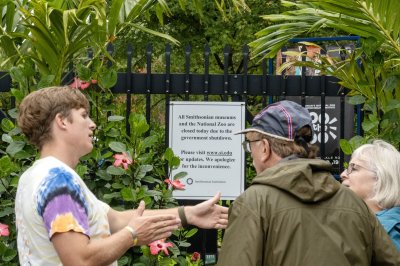
WASHINGTON, Oct. 12 (UPI) — The Smithsonian museums and research centers, along with the National Zoo, closed to the public Sunday for the first time during the federal government shutdown and are likely to remain closed until Congress reaches an agreement over national funding.
Though the shutdown officially began Oct. 1, outside funds from donations and endowments allowed a brief extension. Now, its administrators said, the Smithsonian complex must cease public operations until a budget deal.
The closures affect what had been one of the most accessible forms of public education and sightseeing in the United States With 21 museums, 14 research centers and the National Zoo, the Smithsonian is the largest museum and research network in the world.
The absence of open museums cast a palpable gloom over the capital. Though the weekend brought rainy weather that may have suppressed tourism anyway, the lack of activity around the National Mall left the area unusually quiet.
Washington’s reputation as a destination for cultural visitors has long been tied to its museums, and their closure underscores how dependent the city is on federal operations and how vulnerable that model becomes in shutdowns.
Moreover, many district residents work at various Smithsonian complexes, and the shutdown means a majority of Smithsonian staff members have been furloughed. Some essential operations, like at the National Zoo, must continue for animal care, using existing reserves.
The 163-acre public zoo is home to more than 2,200 animals. The private Conservation Biology Institute is in Front Royal Va., 73 miles away. The two employ in total more than 300 staff members and scientists.
For residents and tourists, the museums and zoo had been a “free of cost” option for learning and cultural engagement.
Most of its museums cluster along or near the National Mall, with several other in the D.C. metro area and two facilities in New York City — also closed because of the shutdown.
The portfolio includes institutions devoted to natural history, air and space, African American history and culture, American art and many specialized fields.
In addition to public galleries and exhibitions, the Smithsonian operates research and education centers. These focus on areas like the cnservation Institute, tropical research Institute and conservation biology.